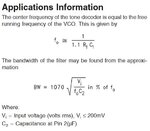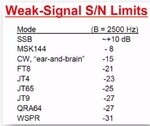neazoi
Advanced Member level 6
Hi I have made a tone detector using the LM567. at pins 5 and 6 a variable resistor should be connected to select the frequency. However I have found that when I do so the only setting that detects tones is the short (i.e pins 5 and 6 shorted. There is a 100nF from pin 6 to GND.
I also have a variable narrow AF filter prior to the LM567. When I set this filter at whatever frequency I want and by feeding the peak frequency tone to it, The LM567 detects that tone ok as long as the input volume to it is at a certain level. It is like the potentiometer between pins 5 and 6 is not needed.
Is that normal?
I also have a variable narrow AF filter prior to the LM567. When I set this filter at whatever frequency I want and by feeding the peak frequency tone to it, The LM567 detects that tone ok as long as the input volume to it is at a certain level. It is like the potentiometer between pins 5 and 6 is not needed.
Is that normal?


